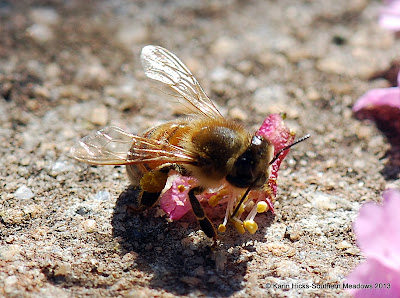A Deeper Level of Communication
The cherry trees are our earliest blooming trees beautifying the garden every February. Well, until the temperatures plummet and put a damper on the pink party.
Both the bees and blooms respond to the first warm, sunny day. It is fascinating to watch these fuzzy pollinators as they amble from bloom to bloom.
These busy bees are filling their pollen sacs with up to a million grains of pollen. Just look at the size of that yummy pollen.
A new study has just been published where scientists from the University of Bristol discovered that plants are able to communicate using electric fields.
Amazingly the bees could distinguish between different floral fields as if they were petal colors. The scientists are not sure how the bees detect the electric fields but one theory is that the electrostatic force makes their hair bristle. The plant's electrical potential changed when a bee visited the flower and remained that way for a few minutes. The thinking is that it may be the way the plant lets other bees know that it is temporarily closed for business and to come back in a little while.
Whether it is electrical fields, color, pattern or scent, the bees love these blossoms, even when they've fallen on the ground.
I'll wrestle you for some pollen!
Both the bees and blooms respond to the first warm, sunny day. It is fascinating to watch these fuzzy pollinators as they amble from bloom to bloom.
These busy bees are filling their pollen sacs with up to a million grains of pollen. Just look at the size of that yummy pollen.
How do they do it so efficiently?
We know that plants have formed associations with pollinators over millions of years to ensure pollination and survival. Plants provide many clues to pollinators using bright colors, patterns and scents to encourage visits.
Vision is very important to bees. Flowers look differently to them. If anything they are even more beautiful! They see things at the blue end of our visual spectrum, hence they don't see the color red. But they do see ultra-violet light patterns that we can not detect. Many flowers have a very distinct UV color pattern that are incredibly eye-catching to bees. You can see an impressive collection of flowers photographed in ultra-violet light (available here). This is how the blooms in your garden look to a bee.
But scientists have discovered a deeper level of communication between flowers and bees.
New study
"Plants are known to emit weak negatively charged electric fields and bees acquire a positive charge of up to 200 volts as they fly through the air. As a charged bee approaches a flower, the difference in electrical potential is not enough to produce sparks but can be felt by the insect."
Amazingly the bees could distinguish between different floral fields as if they were petal colors. The scientists are not sure how the bees detect the electric fields but one theory is that the electrostatic force makes their hair bristle. The plant's electrical potential changed when a bee visited the flower and remained that way for a few minutes. The thinking is that it may be the way the plant lets other bees know that it is temporarily closed for business and to come back in a little while.
Whether it is electrical fields, color, pattern or scent, the bees love these blossoms, even when they've fallen on the ground.
I'll wrestle you for some pollen!






.png)
